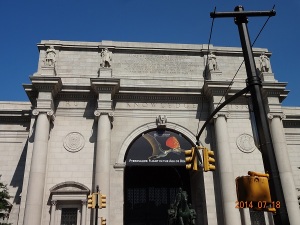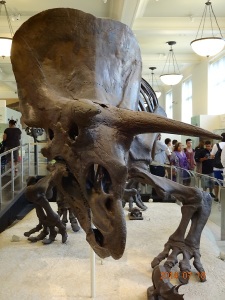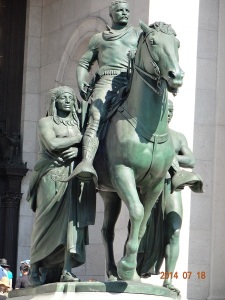
The American Museum of Natural History
The American Museum of Natural History (AMNH), with an entrance from the B subway line at 81st Street, is the counterpart of, and complementary to, the Metropolitan Museum. By counterpart I mean that it is the history of nature, not culture. By complementary, I mean that my last sentence is not quite true, at least by our modern standards. More on that in a minute.
On Friday, I met my friend and colleague Caroline at the main entrance to the museum. Like the Met, there was already a long line, so we walked across the street and sat in the shade of the trees in Central Park. Central Park separates the Met and the AMNH, which are almost directly across from each other. After our visit, we walked across the park, passed the Met, and went to lunch on the East Side.
-

-
The grand, imperial statue of Teddy Roosevelt in front of the AMNH
-

-
Teddy’s front …
-

-
… and Teddy’s back. Notice the Indian and African on either side of Teddy’s horse
The Met and the AMNH are linked whether or not they want to admit it or not. You see, the AMNH contains the not only natural history but also materials from the cultures of the Native Americans, the Africans and the Asians–basically anyone who did not descend from Europeans. There are glass cases where the “costumes” of these different groups are put on manikins made up to look like the races they represent. Caroline has always had an affinity for anything Native American, so I jokingly asked her if she wanted to walk through the cultural galleries. She was horrified and told me no. I had no interest in it, either, so we skipped them.
-

-
From the lobby wall. Teddy help broker a peace that ended the Russo-Japanese War
-

-
Not sure who these people represent, but they look good, don’t they?
A digression. Thursday night, I had drinks and dinner with Jerry, my friend and colleague from New York University. I was talking to him about the AMNH’s galleries on the cultural histories of Asia, Africa and the Native Americans and he pointed out that ethnology, the study of races, came out of natural history. Ethnology is a branch of anthropology, and this is a division in the AMNH.
-

-
The mountain lion exhibit
-

-
These animals have such long tails that I couldn’t get them into the photo
-

-
This one’s paw reminded Caroline of her cat’s kneading
From my perspective, anthropology is a social science, not a natural science. However, I’m sure that there are people who would debate this. (I also consider history a social science.) From my–and Caroline’s–way of thinking, these artifacts are cultural rather than natural, so they belong in the Met, which deals with cultural history. Besides, the Met has “curatorial departments” that deal with anthropological/ethnological materials as well, of which a good deal of their collection is made-up.
-

-
You come around a corner and you find this
-

-

-
Stick this in the closet at Halloween and see how many people you can scare
The AMNH would never give up the cultural artifacts that they have in their collection. One reason is because the AMNH and the Met are two entirely separate institutions. (Would the Met even have the room to store and display these artifacts? I doubt it.) Another reason is that a substantial part of the AMNH’s gift shop for adults is given over to cultural objects from the peoples represented in the collection. Actually, the AMNH gift shop is much nicer than the Met’s, probably because at least half the Met’s gift shop is given over to books; it’s more an art book/gift shop. The AMNH gift shop has a warm feeling to it that the Met’s doesn’t. Unfortunately, I didn’t think to take a pic of the gift shop.

My favorite dinosaur, Triceratops
The collection of dinosaurs is what I really wanted to see, but we walked around some, starting with the mammals and moving into the dinosaurs.
The AMNH is quite a big museum. The dinosaurs are on the top floor, and the place was a zoo. There were a lot of kids from the different summer camps. Caroline thinks that coming to this museum late in the afternoon, like around 3, would be best because all the children would have left to go back to their camps.
As I said, we walked across town and ate at Beyoglu, a Turkish restaurant on Third Avenue. Follow the link to the reviews. The one stand-out criticism is the service, and the reviewers are right. The food is wonderful, but the service leaves something to be desired. We only drank water and for the longest time we had nothing to drink; our waiter never came back to ask us if everything was okay. Caroline, who had a view of the floor, told me to look around at the water glasses on every table; they were empty. The waiter was good-looking; I wondered if he was another unemployed actor (most are). And when we finally got water, the waiter would bring over new glasses instead of bringing over the pitcher, so there were six glasses on the table by the time we left.

























